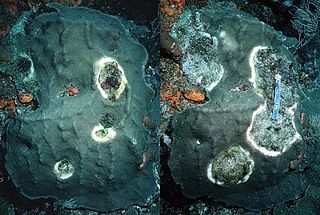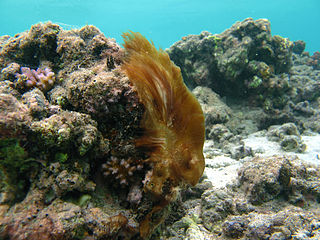
Cyanobacteria, also known as Cyanophyta, are a phylum of Gram-negative bacteria that obtain energy via photosynthesis. The name cyanobacteria comes from their color, giving them their other name, "blue-green algae", though modern botanists restrict the term algae to eukaryotes and do not apply it to cyanobacteria, which are prokaryotes. They appear to have originated in freshwater or a terrestrial environment. Sericytochromatia, the proposed name of the paraphyletic and most basal group, is the ancestor of both the non-photosynthetic group Melainabacteria and the photosynthetic cyanobacteria, also called Oxyphotobacteria.

Geosmin ( jee-AHZ-mən) is an irregular sesquiterpene, produced from the universal sesquiterpene precursor farnesyl pyrophosphate (also known as farnesyl diphosphate), in a two-step Mg2+-dependent reaction. Geosmin, along with the irregular monoterpene 2-methylisoborneol, together account for the majority of biologically-caused taste and odor outbreaks in drinking water worldwide. Geosmin has a distinct earthy or musty odor, which most people can easily smell. The geosmin odor detection threshold in humans is very low, ranging from 0.006 to 0.01 micrograms per liter in water. Geosmin is also responsible for the earthy taste of beetroots and a contributor to the strong scent (petrichor) that occurs in the air when rain falls after a dry spell of weather or when soil is disturbed.

White band disease is a coral disease that affects acroporid corals and is distinguishable by the white band of exposed coral skeleton that it forms. The disease completely destroys the coral tissue of Caribbean acroporid corals, specifically elkhorn coral and staghorn coral. The disease exhibits a pronounced division between the remaining coral tissue and the exposed coral skeleton. These symptoms are similar to white plague, except that white band disease is only found on acroporid corals, and white plague has not been found on any acroporid corals. It is part of a class of similar disease known as "white syndromes", many of which may be linked to species of Vibrio bacteria. While the pathogen for this disease has not been identified, Vibrio carchariae may be one of its factors. The degradation of coral tissue usually begins at the base of the coral, working its way up to the branch tips, but it can begin in the middle of a branch.

Black band disease is a coral disease in which corals develop a black band. It is characterized by complete tissue degradation due to a pathogenic microbial consortium. The mat is present between apparently healthy coral tissue and freshly exposed coral skeleton.

Anatoxin-a, also known as Very Fast Death Factor (VFDF), is a secondary, bicyclic amine alkaloid and cyanotoxin with acute neurotoxicity. It was first discovered in the early 1960s in Canada, and was isolated in 1972. The toxin is produced by multiple genera of cyanobacteria and has been reported in North America, South America, Central America, Europe, Africa, Asia, and Oceania. Symptoms of anatoxin-a toxicity include loss of coordination, muscular fasciculations, convulsions and death by respiratory paralysis. Its mode of action is through the nicotinic acetylcholine receptor (nAchR) where it mimics the binding of the receptor's natural ligand, acetylcholine. As such, anatoxin-a has been used for medicinal purposes to investigate diseases characterized by low acetylcholine levels. Due to its high toxicity and potential presence in drinking water, anatoxin-a poses a threat to animals, including humans. While methods for detection and water treatment exist, scientists have called for more research to improve reliability and efficacy. Anatoxin-a is not to be confused with guanitoxin, another potent cyanotoxin that has a similar mechanism of action to that of anatoxin-a and is produced by many of the same cyanobacteria genera, but is structurally unrelated.
Skeletal eroding band (SEB) is a disease of corals that appears as a black or dark gray band that slowly advances over corals, leaving a spotted region of dead coral in its wake. It is the most common disease of corals in the Indian and Pacific Oceans, and is also found in the Red Sea.
Ablation Valley, also known as Ablation Bay, is a mainly ice-free valley on the east coast of Alexander Island, 3 km (1.9 mi) long, which is entered immediately south of Ablation Point, opens on George VI Sound and lies immediately north of Ganymede Heights. It was first photographed from the air on 23 November 1935 by Lincoln Ellsworth and mapped from these photographs by W.L.G. Joerg. It was first visited and surveyed in 1936 by the British Graham Land Expedition (BGLE), and given the name "Ablation" by them because of the relatively small amounts of snow and ice found there. The site lies within Antarctic Specially Protected Area (ASPA) No.147.
The Chloroflexi or Chlorobacteria are a phylum of bacteria containing isolates with a diversity of phenotypes, including members that are aerobic thermophiles, which use oxygen and grow well in high temperatures; anoxygenic phototrophs, which use light for photosynthesis ; and anaerobic halorespirers, which uses halogenated organics as electron acceptors.

2-Methylisoborneol (MIB) is an irregular monoterpene derived from the universal monoterpene precursor geranyl pyrophosphate. MIB and the irregular sesquiterpene geosmin together account for the majority of biologically-caused taste and odor outbreaks in drinking water worldwide. MIB has a distinct earthy or musty odor, which most people can easily smell. The odor detection threshold of MIB is very low, ranging from 0.002 to 0.02 micrograms per liter in water. MIB is also a factor in cork taint in winemaking.

White pox disease, first noted in 1996 on coral reefs near the Florida keys, is a coral disease affecting Elkhorn coral throughout the Caribbean. It causes irregular white patches or blotches on the coral that result from the loss of coral tissue. These patches distinguish white pox disease from white band disease which produces a distinctive white band where the coral skeleton has been denuded. The blotches caused by this disease are also clearly differentiated from coral bleaching and scars caused by coral-eating snails. It is very contagious, spreading to nearby coral.

Yellow-band disease is a coral disease that attacks colonies of coral at a time when coral is already under stress from pollution, overfishing, and climate change. It is characterized by large blotches or patches of bleached, yellowed tissue on Caribbean scleractinian corals.
The Sippewissett microbial mat is a microbial mat in the Sippewissett Salt Marsh located along the lower eastern Buzzards Bay shoreline of Cape Cod, about 5 miles north of Woods Hole and 1 mile southwest of West Falmouth, Massachusetts, in the United States. The marsh has two regions, the Great Sippewisset Marsh to the north and Little Sippewisset Marsh to the south, separated from each other by a narrow tongue of land. The marsh extends into an estuary in which the intertidal zone provides a dynamic environment that supports a diverse ecology, including threatened and endangered species such as the roseate tern. The ecology of the salt marsh is based in and supported by the microbial mats which cover the ground of the marsh.
Phobotaxis is a random behavioral response to all forms of aversive stimuli. A positive phobic response is one in which either activity is increased or the organism moves toward the stimulus, while a negative phobic response is when activity is decreased or the organism moves away from the stimulus. On the bacterial level, phobotaxis is regularly seen in accordance with phototaxis, random movement in response to light. In the protobacteria Rhodospirillum rubrum, the presence of ferric ion does not create a favorable wavelength of light for physiological activity. This elicits a positive photophobotactic response where the protobacteria moves towards blue and near-UV light. While the phobic response is classified as a photophobotactic response, the photochemical product of ferric complex in medium acts as a chemical stimulus, making this an example of chemotaxis as well. In the eukaryote Euglena, positive phototaxis and positive phobotaxis exhibit nearly the same action spectra, providing more evidence for their association. There also exists evidence to support photophobotaxis being coupled with electron transport needed in photosynthesis for two specific algaes: Phormidium uncinatum and Ph. autumnale. While there does not exist much evidence of phobotaxis in response to tactile stimuli, there is evidence to suggest species will respond in ways that will maximize necessary resources such as food. An experiment that simulated trail movements of trace fossils in the Ediacaran-Cambrian transition showed that those who engaged in phobotaxis, as in avoiding trails which indicate already exploited areas, gained more resources and had higher search efficiency. This foraging for resources involves changes in patchiness, which combines gravitaxis, movement in response to changes in gravity, and chemoreception to identify the spatial pattern of odors and move in response to chemical gradients.
The hoiamides are a class of small molecules recently characterized from isolations of secondary metabolites of cyanobacteria that feature a triheterocyclic system. Hoiamide A and B are cyclic while Hoiamide C and D are linear. Hoiamide A and B demonstrate neurotoxicity by acting on mammalian voltage gated sodium channels, while hoiamide D shows inhibition of the p53/MDM2 complex. The hoiamides are promising therapeutic targets, making their total synthesis an attractive feat.

Edith Kann was an Austrian teacher and botanist, specializing in phycology. She was a leading expert on blue-green algae.

Susanna Wood is a New Zealand scientist whose research focuses on understanding, protecting and restoring New Zealand's freshwater environments. One of her particular areas of expertise is the ecology, toxin production, and impacts of toxic freshwater cyanobacteria in lakes and rivers. Wood is active in advocating for the incorporation of DNA-based tools such as metabarcoding, genomics and metagenomics for characterising and understanding aquatic ecosystems and investigating the climate and anthropogenic drivers of water quality change in New Zealand lakes. She has consulted for government departments and regional authorities and co-leads a nationwide programme Lakes380 that aims to obtain an overview of the health of New Zealand's lakes using paleoenvironmental reconstructions. Wood is a senior scientist at the Cawthron Institute.

Cyanobacteria are a large and diverse phylum of bacteria defined by their unique combination of pigments and their ability to perform oxygenic photosynthesis.

Phormidium is a genus of cyanobacteria in the family Oscillatoriaceae.
Phormidium aerugineo-caeruleum is a species of cyanobacteria in the genus Phormidium.
Phormidium ambiguum is a species of cyanobacteria in the genus Phormidium.











